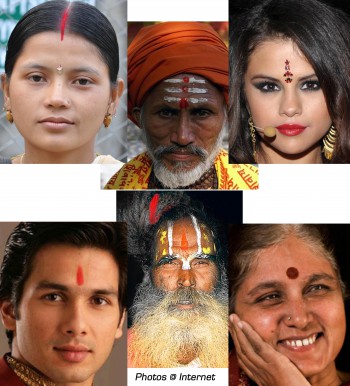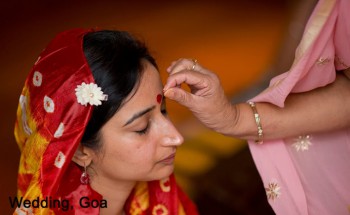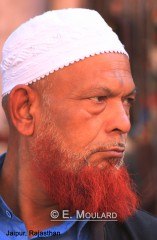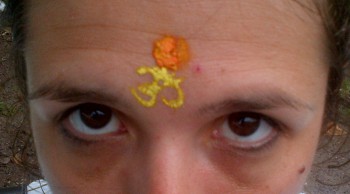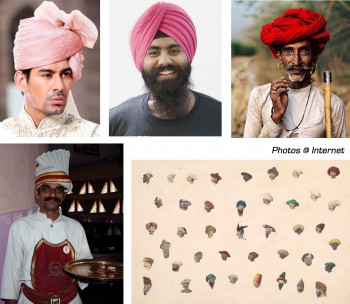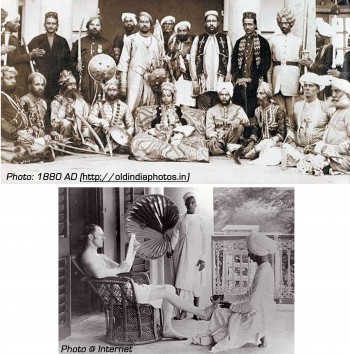10/14/2013
Why in India people have red marks on the forehead?
Or, if we dig deeper, Who, when, how, where?
We can distinguish different ‘marks’: the dot in the middle forehead, the line at the root of the hair and the lines and other designs on the forehead. These marks are often red, but not always. It’s not easy to understand the whole thing!
So who wears what? Does a red dot mean a woman is married?
In North India, the red dot on the forehead would be traditionally the prerogative of married women. But not in South India. Anyway it has become a fashion element, which varies in shape, color and material (the sticker – top right photo – has been giving tough competition to the traditional bindi – bottom right).
It seems however that the sindoor applied at the root of the hair (top left) is only applied by married women (a way of saying don’t touch! – like others do with a ring!).
Men can also wear the tilak, for religious or aesthetic reasons.
In fact anyone (Hindu or not, man or woman, Indian or not) will bear a red mark on the forehead after attending a puja (religious ceremony): whether it's a small prayer at home or in the temple, it always ends by a marking on the forehead...
So... why?
Firstly for aesthetic reasons: Indians find it beautiful! Tastes and colors are not to be discussed...
Secondly the dot on the forehead is a Hindu religious symbol since the tilak, placed on the sixth chakra (‘agna’), represents the third eye or the eye of the mind, associated with deities and the concepts of meditation and spiritual enlightenment. It was originally exclusively for ‘knowledge holders’: idols, priests, ascetics. (1) The Vishnu worshippers’ tilak is a U of white color (obtained from sandalwood) drawn around a red or black line (bottom middle photo). And for Shivaites it is formed by three horizontal lines made from ashes (top middle). (2)
But above all there is a 'scientific' explanation: the body– the forehead and the point 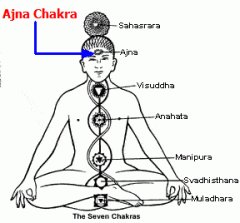 between the two eyes (seat of memory and thoughts) in particular – would produce energy in the form of electromagnetic waves. That’s how stress or anxiety creates heat and causes headaches. (1)
between the two eyes (seat of memory and thoughts) in particular – would produce energy in the form of electromagnetic waves. That’s how stress or anxiety creates heat and causes headaches. (1)
In Tantrism, during meditation, energy flows from the base to the head and leave the body by this point; hence the idea of "plugging the hole" to retain the energy inside. (3)
It is therefore to protect themselves and avoid energy losses that Hindus mark their forehead with a soothing and cooling powder paste.
Indeed, if the 'mark' varies in shape, colour, material and name ('tika', 'pottu', 'sindoor', 'tilak', 'tilakam', 'kumkum' and 'bindi', 'vermilion'), the traditional base (kumkum powder) is obtained by adding a few drop of lime to the yellow turmeric powder which then turns red (and add a little water to make it a paste). Some recipes contain saffron. And it turns out that both turmeric and saffron have medicinal properties as pain-killers! (4)
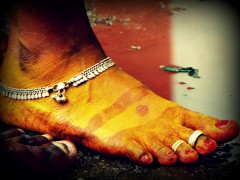 Turmeric is very present in the Indian culture. For example, in Andhra Pradesh, women used to apply it on (and under) the feet every day to protect them (because there were not too many shoes at the time (not that everyone wears shoes today either)). (5)
Turmeric is very present in the Indian culture. For example, in Andhra Pradesh, women used to apply it on (and under) the feet every day to protect them (because there were not too many shoes at the time (not that everyone wears shoes today either)). (5)
Indians may not have invented hot water* (not that they really need it anyways!) but their knowledge about medicinal plants is simply fascinating! Take henna. Not only is it cooling,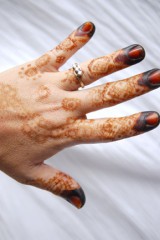 but also it is a coagulant for open wounds. Hence the tradition of Indian women to apply henna on their fingertips to protect themselves from the injuries inherent to manual chores. (6)
but also it is a coagulant for open wounds. Hence the tradition of Indian women to apply henna on their fingertips to protect themselves from the injuries inherent to manual chores. (6)
Here I owe an apology to my mother... After asking a thousand questions she came up with this one: “Tell me, why do these men have orange hair and beard?” I was a little bit upset with myself for not knowing the answer so I just told her whatever non-sense came to my mind: it is because they have used a bad quality dye which has faded!
In fact it seems that some men voluntary decide to have orange hair by dying it with henna. Apparently it could be because some Indians want to hide their gray hair but don’t have enough money to buy a good quality (black) dye. (7) The use of henna can also be linked to religion, as Islam would prohibit any dye except for henna. (8) When I asked my salesguy why do some people have orange hair he just told me that when people start to have gray hair they dye it, sometimes in black, sometimes in orange. No need to overthink it! You see Mum… ;)
* Sheer provocation?? Not only ! Apart from the zero, difficult to think of anything Indians actually invented… It doesn’t mean they are dumb though… They have stuff like the jugaad (in very short, “the gutsy art of overcoming harsh constraints by improvising an effective solution using limited resources”). Read more here.
(2) http://fr.wikipedia.org/wiki/Tilak
(3) http://hinduism.about.com/od/bindis/a/bindi.htm
(4) http://www.safrandugatinais.fr/en/vertus.htm; http://www.healthdiaries.com/eatthis/20-health-benefits-of-turmeric.html
(5) http://www.nandyala.org/mahanandi/?p=925
(6) http://www.ft.com/cms/s/0/d2933fb0-83de-11dc-a0a6-0000779fd2ac.html#ixzz2fW2qoFNh
(7) http://www.earthhenna.com/c158/c105/c98/The-Henna-Plant-c104.html
(8) http://ask.metafilter.com/88073/Why-would-a-Muslim-man-use-henna-to-dye-his-beard-orange
08:00 Posted in Why in India... | Permalink | Comments (0) | Tags: hair, hairs, beard, jugaad, innovation, orange, dye, henna, turmeric, saffron, spices, red dot, red mark, forehead, chakra, energy, meditation, third eye, tika, pottu, sindoor, tilak, tilakam, kumkum, bindi, agna, puja, kumkum powder, vermilion, orange hair | ![]() Facebook | |
Facebook | |
10/12/2013
Why in India some people don't cut their hair and wear a turban?
Sites dedicated to Sikhism explain that hair is a gift from God and therefore you don’t alter it (1). Moreover hair is beautiful (as any gift from God) then the longer the more beautiful.
That said, I am more and more convinced that any tradition or belief has a practical origin. As a matter of fact, if the Sikh religion appeared in 1469, emerging from the dominant religions (Hinduism and Islam), it is only in 1699 that cutting hair was forbidden (2). Now it so happens that at that time Sikhs were cornered: they had to give up non-violence (a founding principle of this religion) and take up arms against the Muslims who persecuted them (just as they were forcing Hindus to convert). As the Muslims wore beards – also certainly for practical reasons: “Act against the polytheists,” said Muhammad. “Carefully size your moustache and let yourself grow a beard.”(3) – and Hindus were moustachioed. To differentiate themselves (on the battle ground and otherwise) they had only two options left: leave it all or cut it all (but then it’s a lot of maintenance)...
And why the turban?
Long hair may be beautiful but it is not practical. Especially you are fighting and everything. Therefore, “the turban is in all respects a very convenient headgear; it is even more advantageous during war that our hats, because what they fall less easily, and can more easily prepare a blow of cutting edge”. (4) In addition it protects hair from the dust. And women can manage however they want (without a turban)...
But you must know that all turbaned men in India are not necessarily Sikh.
For example, the Rajasthani (top right) people, originally farmers and shepherds living in a mostly desert region, protect their head with a turban. Which varies in shape, size (even if it is usually 8-9 meter long (5)), material, colour and designs according to the wealth, caste and region of the wearer or the occasion.
Men wear turbans during weddings (top left).
And many janitors in big hotels or restaurants servers wear a turban (bottom left). In my opinion this practice dates from the colonial time when the Britishers must have found it classy to dress up their servants like that...
Morality, the turban does not (only) make the Sikh!
Subsidiary questions: How do Sikhs manage at the swimming pool with their turbans? How can Sikhs wear a helmet when on a bike? How do Sikhs pass airport security with their kirpan (dagger (2))?
At the pool, they take off their turbans but keep the piece of cloth th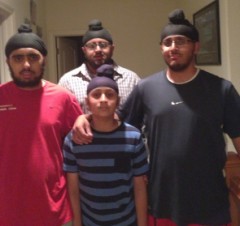 at covers their hair and makes them look like Smurfs and they avoid putting their head under water. Same thing when they play any sport.
at covers their hair and makes them look like Smurfs and they avoid putting their head under water. Same thing when they play any sport.
The regulation regarding helmet-wearing in India is a bit complicated, since it varies from one State to another. In Delhi for example, it is not compulsory for women to wear a helmet! And in Punjab and Haryana where there is a majority of Sikhs, wearing a helmet is simply optional. As a rule, Sikhs are not forced to wear helmets (which are too small to accommodate the turban!).
The Constitution of 1971 permits Sikhs to carry the kirpan in India. As for air-traveling, the kirpan is only allowed in a check-in luggage!
And why do all Sikhs bear the name Singh (men) and Kaur (women)?
Sikhism is an egalitarian religion, condemning discrimination based on gender or caste. Since in India, family names refer to caste, religion, region of origin, profession (yes all this! and it's hyper-complicated!), Sikhs use their ‘middle name’ as a surname. ‘Lion’ for men (Singh) and ‘Princess’ for women (Kaur).
But beware, the name Singh does not (only) make the Sikh.
There are people by the name Singh that are not Sikh. How to make things simple when they can be complicated? J
(1) http://www.realsikhism.com/index.php?subaction=showfull&id=1248365083&ucat=7
(2) Guru Gobind Singh (last of the 10 gurus who have developed the Sikh doctrine) has imposed the 5 kakas (5 K): hair and beard never cut (kesh) and retained by a comb (Adriana) symbolizing neatness, a metal bracelet (kara), military breeches (kachha) and a dagger (kirpan). Source: http://www.thecanadianencyclopedia.com/articles/fr/sikhisme; http://www.lemondedesreligions.fr/archives/2006/03/01/XVe-siecle-gourou-Nanak, 7928403.php
(3) http://www.slate.fr/lien/67915/barbe-moustache-monde-arabe
(4) http://alembert.fr/index.php?option=com_content & id = 640409723
(5) http://www.indianetzone.com/42/turbans.htm
Other sources: http://forums.Bharat-rakshak.com/viewtopic.php?p=600509 ; http://www.fashion.arts.AC.UK/media/research/documents/toolika-Gupta-effect-of-British-Raj-on-Indian-costume.PDF
08:00 Posted in Why in India... | Permalink | Comments (0) | Tags: india, hair, religion, sikh, turban, long hair, beard, moustache, turbaned, sikhism, islam, hinduism, guru, gobind singh, five kakas, kakas, rajasthani, name, singh kaur, warriors, kirpan, airport, motorcycle, helmet, sport | ![]() Facebook | |
Facebook | |
10/10/2013
Why in India people eat with their fingers?
This post is dedicated to one of my French bosses who asked me recently, after a trip in India, if in my opinion “they” would continue to eat with their hands for a long time. “These savages” he might as well have added.
Before I praise the practice of using fingers, a small memo on how the “sophisticated” countries actually stopped it...
“The use of fork dates back to ancient times. The Egyptians already used some kinds of metal hooks for cooking and grabbing food in the pots.
The forks we use today are believed to have appeared in the Byzantine Empire. They were introduced in North Italy in the middle of the eleventh century where they were originally reserved for pasta. 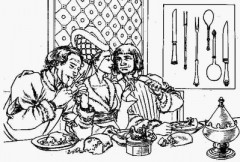
The fork was presented in France by Catherine de Medici but its use first remained very restricted (to cooked pears). Her son, Henri III, during a trip to Italy in 1574 got seduced by this funny tool which enabled people to eat without staining the huge collars or “strawberries”, that were so fashionable. Thus he returned in France with forks and showed it off at his favourite restaurant: Hostellerie de Tour D'Argent (current Tour D'Argent in Paris).
The use of this tool emerged very gradually in France. At the table of Louis XIV, each guest had a fork on the left of their plate, but it was not used because the King himself preferred to eat with his fingers...
It is only at the end of the seventeenth century that the fork was finally used to bring food from the plate to the mouth. It is at the same time that the shape changed, from two to four prongs.”*
So it has been only 400 small years that we stopped eating with our fingers in France!
And I find kind of sad! I think eating with fingers has only advantages. First the food tastes better – it must be the combination of four senses instead of three.
It is more eco-friendly (so much we won’t wash!).
You don’t burn your tongue – but your fingers.
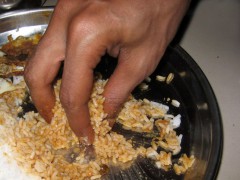 And you don’t get snapped at because you don’t use your fork or knife properly. Well, you may get a comment if you get food up to the palm: according to ‘good manners’** in northern India, where commonly people use bread (chapati) to gather the food, food should not cross the second phalange. In such situation, just reply that you learned to eat in South India where a rules are less strict (instead of chapatis they eat a lot of rice which is not so easy to grab! (But don’t overdo it or youey’ll give the impression to be a pig!)
And you don’t get snapped at because you don’t use your fork or knife properly. Well, you may get a comment if you get food up to the palm: according to ‘good manners’** in northern India, where commonly people use bread (chapati) to gather the food, food should not cross the second phalange. In such situation, just reply that you learned to eat in South India where a rules are less strict (instead of chapatis they eat a lot of rice which is not so easy to grab! (But don’t overdo it or youey’ll give the impression to be a pig!)
The only important thing is to avoid using the left hand. That would be gross! When you think it is the hand dedicated to ass-wiping...
What is funny is that the majority of tourists in India (my mother ahead of the pack) are really disturbed when they have to eat with their hands... And yet don’t we eat French fries and chicken legs with fingers in France?
* Source: http://www.indax.com/eating.htm
08:03 Posted in Why in India... | Permalink | Comments (0) | Tags: india, eating with hands, eating with fingers, hands, fingers, eat, good manners, chapati, roti, rice, fork, history of the fork, food | ![]() Facebook | |
Facebook | |















